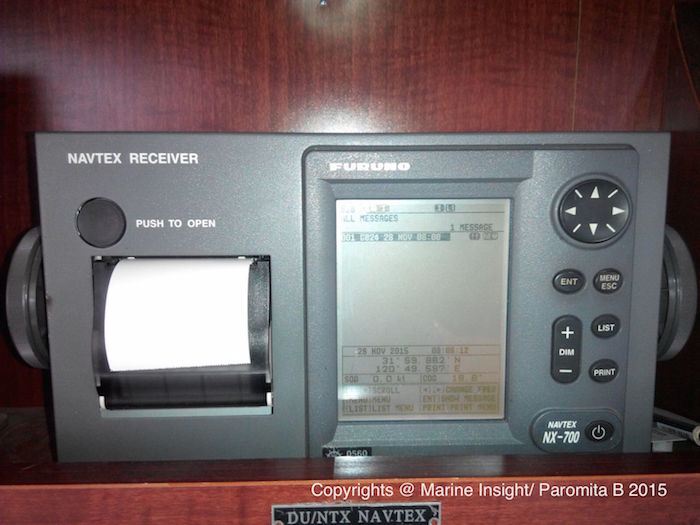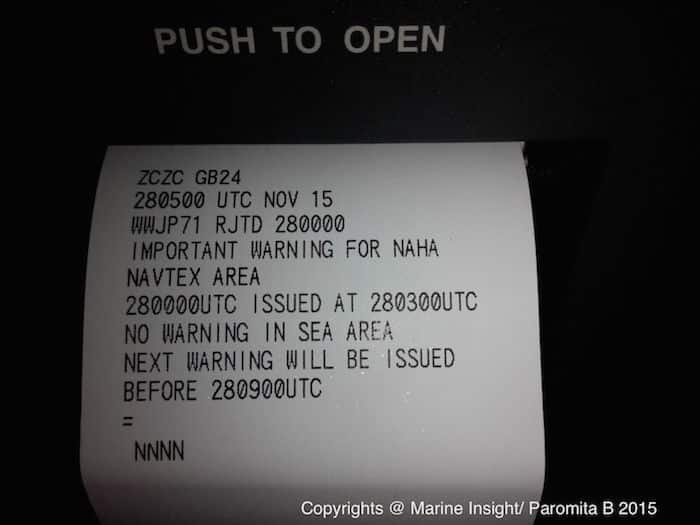

It is of utmost importance that every navigating officer ensures the safety of the vessel and its crew. Accidents can happen to the most cautious and prudent of navigator.
Right from the start of voyage planning, the navigator needs up to date information that will affect the passage of the ship. The most important information to vessels is information related to safety including Maritime Safety Information.
Maritime Safety Information includes navigational and meteorological warnings, meteorological forecasts, warnings about dangers to navigation, warnings of missing vessels and other urgent messages pertaining to the safety of the vessel and its crew.
Constant monitoring to pick up wanted information among a vast volume of messages is not very practical with a limited radio system. The NAVTEX system provides all navigating officers with up to the minute information automatically.


NAVTEX, an acronym for navigational telex (navigational text messages) is a device used on-board the vessels to provide short range Maritime Safety Information in coastal waters automatically.
It can be used in ships of all types and sizes. The area covered by Navtex can extend as far as 400 nautical miles from the broadcast station. A NAVTEX receiver onboard prints out navigational and meteorological warnings and forecasts as well as urgent Marine Safety Information to ships.
It forms a vital element of the Global Maritime Distress Safety System (GMDSS). Navtex uses the feature of radio telex or Narrow Band Direct Printing (NBDP) for the automatic broadcast of information.
The Navtex works on a frequency of 518 kHz in the medium frequency band. 490 kHz frequency is also used by some countries for broadcasts in the national languages, also known as national navtex.
Where medium frequency reception is difficult, transmissions are made on 4209.5 kHz. The default setting in a Navtex is 518 kHz. The entire world is divided into 21 areas known as NAVAREAS (including 5 areas recently introduced for the Arctic region) for the purpose of distributing this information.
Each Navarea has multiple navtex stations which further helps in transmitting the messages.
All navtex receivers are programmable to enable the navigating officer to ensure that only messages from selected Navtex Stations are displayed or printed.
The SELECTING STATION menu under the Menu option in a Navtex Receiver allows the officer to select the desired stations he/she wants to receive automatically or manually.
On automatic selection, the navtex receives Marine Safety Information for the area the ship happens to be in continuously and without any user involvement.
If a ship’s position data is fed from any navigating equipment like GPS, the Navtex will automatically decide in which NAVAREA the ship is navigating presently and thus select the appropriate Navtex Stations.
In the manual mode, the navigating officer can select what stations he/she wishes to receive.
A list of Navtex Stations can be found in the Admiralty List of Radio Signals Volume 3 Part 1 and in the List of Coast Stations and Special Service Stations (List IV) for reference.
The Navtex receives the following kind of messages:
A= Navigational Warning
B= Meteorological Warning
C= Ice report
D= Search and Rescue Information/ piracy and armed robbery
E= Meteorological forecast
F= Pilot messages
G= AIS messages(formerly Decca messages)
H= Loran C messages
I= Omega messages
J= Satnav messages (GPS or GLONASS)
K= Other electronic navigational aid system messages
L= navigational warnings (additional)
M to U= Reserve
V= Notice to fisherman
W to Y= Reserve
Z= No messages on hand
The navtex receiver can be set to ignore certain types of messages, however, messages A,B,D and L because of their importance cannot be rejected by navigating officers.
Audible alarms can also be generated when message type A,B,D or L is received. It should only be possible to reset this alarm manually.
We should also note that when programming the type of messages to receive, it is wise to ensure that only those which are required and necessary are programmed for the reception.
Otherwise, a good deal of paper will be wasted or one will have to scroll through a mass of messages if the broadcasts are received in soft copy.


The message in a Navtex Receiver appears in the following format:
ZCZC b1 b2 b3 b4 MAIN MESSAGE NNNN
ZCZC: It is the start code. It indicates the beginning of the message.
B1: This character represents the Station ID.
B2: This character is called the Subject Indicator. It is used to represent the type of message. (A to Z)
The characters B1 and B2 are used by the navtex receivers to reject messages from stations of concerning subjects of no interest to the officer.
B3 and B4: B3 and B4 is a 2 digit serial number for each message.
NNNN: This indicates the end of the message.
The characters B3 and B4 are used by receivers to keep already received message from being repeated.
Below is an example of a message:
ZCZC OA20
WZ 1593
Scotland, West Coast
The North cardinal light buoy 58.01.2N 005.27.1W
have been permanently withdrawn.
Cancel WZ 1562
NNNN
Every Navtex message has information within the message header. In the above message:
The letter “O” indicates a broadcast from the Navtex station, here Portpatrick radio.
“A” indicates a Navigational warning category message.
‘20’ indicates the navigational warning message priority sequence.
ADVANTAGES OF HAVING NAVTEX ONBOARD THE SHIPS:
Navtex is a form of extra insurance and aid in the peace of mind. It is a very convenient way of monitoring navigational warnings, meteorological warnings, search and rescue information and other data for ships sailing within 200 to 400 nautical miles off the coast. It thus provides pertinent navigational and weather-related information in real-time.
As Navtex receiver receives messages automatically it is quite a user friendly. An officer of the watch does not have to monitor it regularly or be physically present at a fixed time.
There is also no requirement for retuning of the receiver. This not only saves time but also stops an officer from being distracted on the bridge.
With the information received from the Navtex receiver, passage plan can be amended as required for the safety of the vessel.
An officer of the watch can attend to any distress warning in the vicinity. He is also aware of the expected weather and can plan accordingly. Thus a Navtex forms an integral part of the bridge navigational equipment.
Navtex is mandatory to be carried by all SOLAS approved vessels. It is small but powerful equipment. It provides safety information that can be tailored as per one’s particular needs.
Over to you..
Do you know any other important points on NAVTEX that can be added to this article?
Let’s know in the comments below.










We believe that knowledge is power, and we’re committed to empowering our readers with the information and resources they need to succeed in the merchant navy industry.
Whether you’re looking for advice on career planning, news and analysis, or just want to connect with other aspiring merchant navy applicants, The Marine Learners is the place to be.